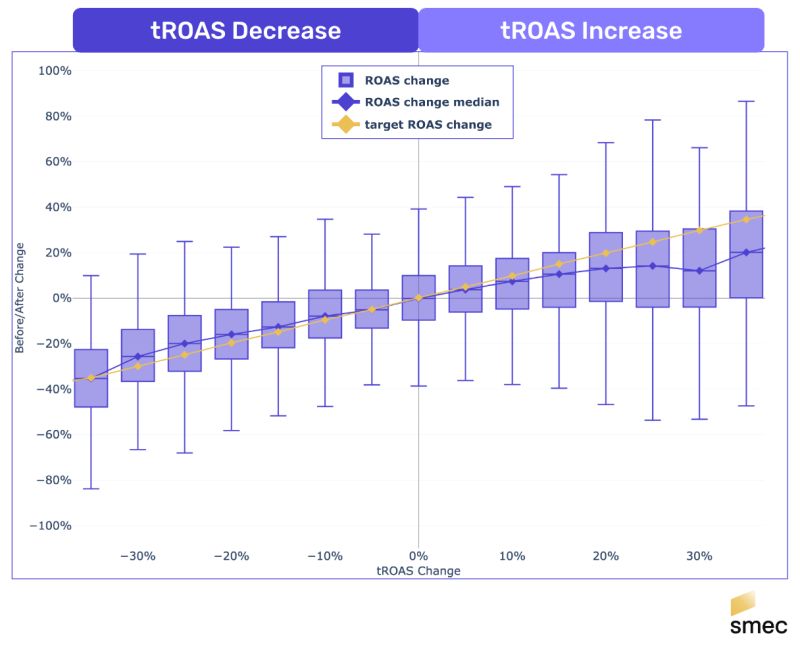Subscribe to join thousands of other ecommerce experts

Adjusting your target ROAS (tROAS) in Google Ads might feel like a straightforward task, but the reality can be a bit trickier. At Smarter Ecommerce (smec), we’ve gathered insights from over 12 months of campaign data to understand the impact of target ROAS changes on actual campaign performance. To help break it down, we’ve compiled this handy FAQ guide to answer the most common questions about what happens when you make changes to your tROAS.
When you adjust your target ROAS, you’re telling Google’s algorithm to prioritize either efficiency or volume based on your business goals. But here’s the twist: while the algorithm tries its best to hit your new target, the results can be unpredictable.
In our analysis of 600 Performance Max (PMax) campaigns, we found that actual ROAS doesn’t always follow the target as neatly as you might expect. For example, even when we reduced tROAS by 35%, some campaigns saw an increase in actual ROAS! It’s a noisy environment, and results can vary, especially with large changes.

When you make a tROAS change, the key is to understand the relationship between your target and the actual outcomes. We recommend visualizing it like this:
– The yellow line represents your target change (+5%, +10%, etc.).
– The purple line shows the actual change in ROAS.
Ideally, the purple line should closely follow the yellow line, but in practice, you’ll often see a gap—especially for larger changes. This gap indicates that the algorithm is struggling to meet your target due to constraints like budget, saturation, or demand.
Not exactly. Making significant changes to your tROAS—let’s say more than 30%—can actually lead to diminishing returns. We call this the saturation effect. When you push tROAS too high, you might hit an efficiency ceiling, meaning the algorithm can’t squeeze out more performance because it’s constrained by factors like budget, demand, or simply the limits of optimization.
In simpler terms, a big target change might not give you a proportional increase in actual ROAS.
It all comes down to the inherent volatility of Google’s algorithm. Adjusting your tROAS is like steering a sailboat—small adjustments can lead to noticeable shifts, but strong winds (or in this case, other variables) can make the outcomes unpredictable. For example, when we left tROAS unchanged in some campaigns, we still saw a range of different results in actual ROAS.
Increases to tROAS tend to trigger more volatility compared to decreases, which means you’ll want to monitor those increases closely and avoid sudden, drastic changes.
If you notice unexpected swings in your campaign performance after changing tROAS, here’s what we recommend:
– Start small: Make incremental adjustments, aiming for changes under 30%.
– Watch your data: Track performance for at least 30 days before making further adjustments.
– Avoid frequent changes: Too many tROAS adjustments can confuse the algorithm. Think of it like a thermostat—you don’t want to constantly crank it up and down.
Yes! Campaigns with more than 60 monthly conversions tend to be more stable and can handle tROAS adjustments more predictably. On the flip side, campaigns with fewer conversions are more volatile and less predictable when you change tROAS targets.
Additionally, we’ve found that PMax campaigns generally handle tROAS decreases better than increases, so if you’re looking to lower your targets, the results are likely to be more consistent.
Seasonality plays a big role in how well your campaigns respond to tROAS changes. For key periods like Black Friday or Christmas, you’ll want to start making adjustments well in advance. We recommend setting your seasonal adjustments early, rather than relying on last-minute tweaks to your tROAS.
Additionally, consider using seasonality adjustments in Google Ads to inform the algorithm of expected shifts in performance during peak periods. This will help smooth out any rough patches that could arise from sudden changes in demand.
Large tROAS changes—anything over 30%—should be handled with care. Instead of making a huge adjustment all at once, try breaking it down into smaller steps. This gives the algorithm time to adjust, minimizing the risk of extreme volatility.
For example, instead of raising your tROAS from 400% to 500% overnight, try a series of smaller increases, allowing the algorithm to recalibrate along the way.
Absolutely! Here’s a quick list of things to keep in mind:
– Don’t change tROAS too often—the algorithm needs time to settle after each adjustment.
– Monitor performance for at least 30 days after a tROAS change before making any conclusions.
– Use smaller changes to reduce volatility and keep campaigns on track.
– For peak seasons, make adjustments early and consider seasonality tools to avoid last-minute scrambling.
Conclusion
Target ROAS changes aren’t just about tweaking a setting—they can trigger a complex set of reactions in your campaigns. While Google’s algorithm tries to follow your lead, there’s always a degree of unpredictability. The key is to start small, stay patient, and monitor your data carefully.
Those answered are based on our extensive research upon 12 months of changelog data for thousands of campaigns. You can read the full story here on LinkedIn.
Need help navigating your tROAS changes or dealing with volatile results? At smec, we’ve got the expertise and tools to help you steer the ship and keep your campaigns on course — just get in touch.

